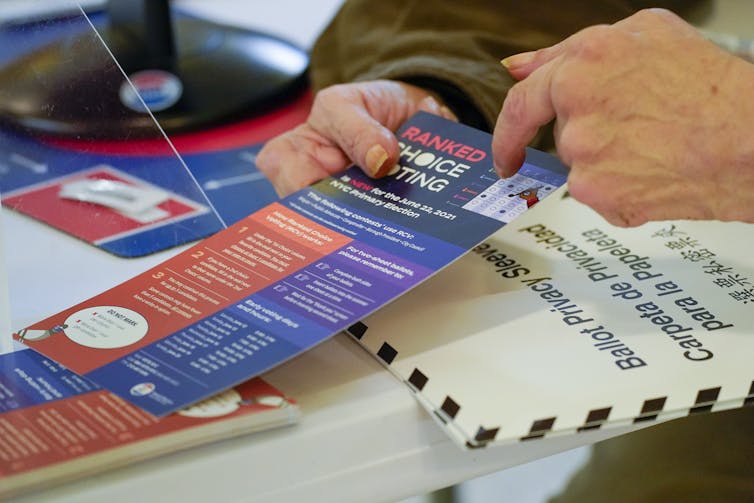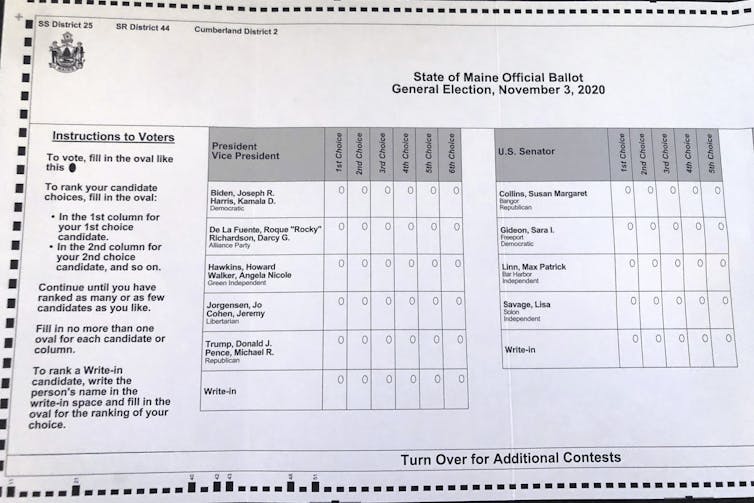What is ranked choice voting? A political scientist explains
- Written by Joshua Holzer, Assistant Professor of Political Science, Westminster College
Ranked choice voting is on the rise[1] in the United States, with nearly two dozen places[2] now using the system for various offices including, most recently, New York City[3] for its mayoral primary elections.
By the end of 2021, more than 20 Utah municipalities[4] will be using this method, which lets voters rank candidates in order of preference. Two cities in Minnesota will also try it this year: Bloomington and Minnetonka[5]. By 2022, the state of Alaska[6] will be using a variation of the system, as will the California cities of Albany, Eureka and Palm Desert[7]. By 2023, Boulder[8], Colorado, and Burlington[9], Vermont, will also be using it.
Although it was new for New Yorkers this summer, Australians have been using ranked choice voting[10], which they call “preferential voting[11],” for more than 100 years[12] to elect members to their House of Representatives[13].
Advocates argue that ranked choice voting solves the problems[14] of other voting methods, while detractors counter that it makes elections unnecessarily complicated[15].
 New York City spent a lot of time explaining to voters how their new method of voting would work.
AP Photo/Mary Altaffer[16]
New York City spent a lot of time explaining to voters how their new method of voting would work.
AP Photo/Mary Altaffer[16]
Commonly used voting systems
In the U.S., plurality voting[17] is the most commonly used[18] system to elect people to serve in government. Using this method, whichever candidate has the most votes after a single round wins. Proponents of plurality voting point out that it is simple to understand[19] and easy to implement.
One problem arises[20], however, when there are several people running for office. In those cases, the vote could be split[21] several ways, and the overall winner may not actually be very popular.
For example, in 2002[22], John Baldacci[23], a Democrat, defeated three other candidates to become governor of Maine after winning 47.2% of the vote. In 2006[24], when facing four other candidates, he was reelected with only 38.1% of the vote. In 2010[25], Paul LePage[26], a Republican, similarly ran against four other candidates, ultimately winning the governorship with 37.6% of the vote. In 2014[27], when he ran against two other candidates, LePage was reelected with 48.2% of the vote.
In other words, for more than a decade Maine had a governor whom the majority of voters had actually voted against. Both Democrats and Republicans pointed to back-to-back terms where an unpopular candidate from the other party was elected by winning only a narrow plurality.
Some places that have experienced these sorts of results have chosen to adopt an electoral system aimed at ensuring that winners have majority support[28], such as runoff voting[29]. Typically[30] if a candidate gets more than half the votes in the first round, that candidate is declared the winner. If not, the two candidates with the most first-round votes face off in a second round of voting.
This method, which can lead to several rounds of elections – particularly if it’s also used during the primaries – can be expensive for the government to organize[31], and it requires voters to take additional time off work and other duties, which can reduce voter turnout[32]. Furthermore, in some parts of the U.S., runoff elections still carry racist overtones[33].
 Both John Baldacci, left, and Paul LePage won the governorship of Maine despite receiving less than a majority of the vote.
Andy Molloy/Portland Press Herald via Getty Images[34]
Both John Baldacci, left, and Paul LePage won the governorship of Maine despite receiving less than a majority of the vote.
Andy Molloy/Portland Press Herald via Getty Images[34]
Pros of ranked choice voting
In hopes of ensuring that winners have majority support while minimizing the downsides of runoff voting, some places have experimented with ranked choice voting.
For instance, in Maine in 2016, voters were sour from four gubernatorial elections in which the winner got less than a majority of the votes cast. This led to the adoption of ranked choice voting[35].
The way this system typically works is that voters rank candidates in order of preference. A candidate can win outright by receiving the majority of first-preference votes. If that doesn’t happen, the candidate with the fewest first-preference votes is eliminated, and voters who picked that candidate as their first choice will have their next choice counted[36]. If there still is not a winner, then the candidate with the next fewest votes is also eliminated. This process continues with candidates eliminated one by one until one candidate has obtained a majority.
Proponents of ranked choice voting[37] argue that, unlike plurality voting[38], voters can vote for their favorite candidate without worrying that their vote might inadvertently help an unpopular candidate get elected with less than a majority, as was the case in Maine with Baldacci and LePage. Although runoff voting helps to solve this problem by allowing for a potential second round, ranked choice voting takes less time and money because all votes are cast on one day on one ballot.
After Maine adopted ranked choice voting, Democrat Janet Mills[39] became the first gubernatorial candidate in the state to win a majority since 1998[40] and the first nonincumbent to do so since 1966[41].
Given that voters get to rank multiple candidates, another potential benefit of ranked choice voting is that it can encourage cooperation between candidates[42] as they vie for voters’ second, or subsequent, preferences. In 2018, for instance, Mark Eves and Betsy Sweet, both of whom were competing in Maine’s Democratic primary for governor, urged their supporters to rank the other as their second choice[43]. During the recent Democratic primary for mayor of New York, a similar alliance emerged between Andrew Yang and Kathryn Garcia[44].
Not all candidates seek to form such arrangements. Eric Adams[45], a Black candidate who ultimately bested both Yang and Garcia, decried their electoral alliance as a form of racist voter suppression[46] meant to prevent a person of color from winning. Historically, however, ranked choice voting has boosted the chances of nonwhite candidates[47]. Notably, Maya Wiley[48], a Black woman who was also a candidate in the Democratic primary, disputed Adams’ claim, arguing that the Yang-Garcia[49] “partnership is not racist, and we should not be using this term so loosely.”
 A ranked choice voting ballot, like this one from Maine, lets voters signal in which order they prefer candidates.
AP Photo/David Sharp[50]
A ranked choice voting ballot, like this one from Maine, lets voters signal in which order they prefer candidates.
AP Photo/David Sharp[50]
Disadvantages of the system
Because ranked choice voting is a different system than most Americans are familiar with, one potential problem is confusion. Some critics[51] incorrectly claim that ranked choice voting lets voters cast more than one ballot per person[52], when in fact each voter gets just one vote[53].
In each round, each voter’s single vote is assigned – or, rather, transferred[54] – to their top preference among candidates who can still win the election, as if a runoff round were to happen instantly. As a result, in some places, ranked choice voting is called “single transferable vote[55]” or “instant runoff voting[56].”
[The Conversation’s Politics + Society editors pick need-to-know stories. Sign up for Politics Weekly[57]._]
It is true that voters who are unfamiliar[58] with the details may have problems when voting. Ballots filled out incorrectly, such as by marking the same preference twice[59], can be considered invalid[60]. Also, failing to rank all of the candidates[61] may result in the ballot being ignored in later rounds of counting, depriving[62] the voter of influence. But teaching[63] people how the new system[64] works can likely reduce such problems[65].
In the runup to the primaries in New York City, officials spent US$15 million[66] to teach voters about ranked choice voting. It’s a substantial amount of money, but the cost should drop – eventually, to zero – as more voters become familiar with the process over time.
References
- ^ on the rise (www.nytimes.com)
- ^ nearly two dozen places (www.fairvote.org)
- ^ New York City (apnews.com)
- ^ more than 20 Utah municipalities (www.sltrib.com)
- ^ Bloomington and Minnetonka (www.startribune.com)
- ^ Alaska (ballotpedia.org)
- ^ Albany, Eureka and Palm Desert (www.fairvote.org)
- ^ Boulder (ballotpedia.org)
- ^ Burlington (ballotpedia.org)
- ^ ranked choice voting (ballotpedia.org)
- ^ preferential voting (www.abc.net.au)
- ^ more than 100 years (www.rcvresources.org)
- ^ House of Representatives (www.aph.gov.au)
- ^ solves the problems (www.fairvote.org)
- ^ unnecessarily complicated (bangordailynews.com)
- ^ AP Photo/Mary Altaffer (newsroom.ap.org)
- ^ plurality voting (www.britannica.com)
- ^ most commonly used (ballotpedia.org)
- ^ simple to understand (aceproject.org)
- ^ problem arises (electionscience.org)
- ^ split (archive3.fairvote.org)
- ^ 2002 (www.pressherald.com)
- ^ John Baldacci (www.nga.org)
- ^ 2006 (www.pressherald.com)
- ^ 2010 (www.pressherald.com)
- ^ Paul LePage (www.nga.org)
- ^ 2014 (www.pressherald.com)
- ^ aimed at ensuring that winners have majority support (www.newstribune.com)
- ^ runoff voting (ballotpedia.org)
- ^ Typically (aceproject.org)
- ^ expensive for the government to organize (www.localmemphis.com)
- ^ reduce voter turnout (www.fairvote.org)
- ^ runoff elections still carry racist overtones (theconversation.com)
- ^ Andy Molloy/Portland Press Herald via Getty Images (www.gettyimages.com)
- ^ This led to the adoption of ranked choice voting (theconversation.com)
- ^ voters who picked that candidate as their first choice will have their next choice counted (www.youtube.com)
- ^ Proponents of ranked choice voting (soundcloud.com)
- ^ unlike plurality voting (www.columbiatribune.com)
- ^ Janet Mills (bangordailynews.com)
- ^ 1998 (www.pressherald.com)
- ^ 1966 (www.nga.org)
- ^ cooperation between candidates (www.usatoday.com)
- ^ urged their supporters to rank the other as their second choice (www.economist.com)
- ^ a similar alliance emerged between Andrew Yang and Kathryn Garcia (www.youtube.com)
- ^ Eric Adams (www.usatoday.com)
- ^ racist voter suppression (nymag.com)
- ^ ranked choice voting has boosted the chances of nonwhite candidates (www.realclearpolitics.com)
- ^ Maya Wiley (www.nytimes.com)
- ^ arguing that the Yang-Garcia (www.bloomberg.com)
- ^ AP Photo/David Sharp (newsroom.ap.org)
- ^ Some critics (www.wsj.com)
- ^ cast more than one ballot per person (www.centralmaine.com)
- ^ gets just one vote (www.fairvote.org)
- ^ transferred (dictionary.cambridge.org)
- ^ single transferable vote (www.house.leg.state.mn.us)
- ^ instant runoff voting (dictionary.cambridge.org)
- ^ Sign up for Politics Weekly (theconversation.com)
- ^ unfamiliar (www.doi.org)
- ^ marking the same preference twice (aec.gov.au)
- ^ considered invalid (doi.org)
- ^ failing to rank all of the candidates (www.aec.gov.au)
- ^ depriving (dx.doi.org)
- ^ teaching (dx.doi.org)
- ^ the new system (citeseerx.ist.psu.edu)
- ^ such problems (doi.org)
- ^ US$15 million (www1.nyc.gov)
Read more https://theconversation.com/what-is-ranked-choice-voting-a-political-scientist-explains-165055
















